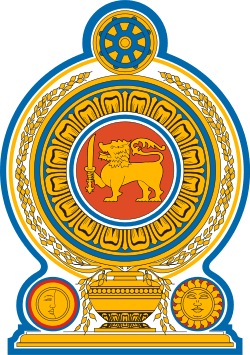Government of Sri Lanka
 |
| This article is part of a series on the politics and government of Sri Lanka |
|
Executive |
|
|
Political parties |
|
|
Administrative geography
|
|
Foreign policy |
|
Related issues
|
|
Politics portal |
The government of Sri Lanka is a semi-presidential system determined by the Sri Lankan Constitution.
Constitution
The Constitution of Sri Lanka has been the constitution of the island nation of Sri Lanka since its original promulgation by the National State Assembly on 7 September 1978. It is Sri Lanka's second republican constitution, and its third constitution since the country's independence (as Ceylon) in 1948. As of September 2010 it has been formally amended 18 times.
Executive branch
The President, directly elected for a six-year term, is head of state, head of government, and commander in chief of the armed forces. The election occurs under the Sri Lankan form of the contingent vote. Responsible to Parliament for the exercise of duties under the constitution and laws, the president may be removed from office by a two-thirds vote of Parliament with the concurrence of the Supreme Court.
The President appoints and heads a cabinet of ministers responsible to Parliament. The President's deputy is the prime minister, who leads the ruling party in Parliament. A parliamentary no-confidence vote requires dissolution of the cabinet and the appointment of a new one by the President.
| Candidate | Party | Votes | % | |
|---|---|---|---|---|
| Maithripala Sirisena | New Democratic Front | 6,217,162 | 51.28% | |
| Mahinda Rajapaksa | United People's Freedom Alliance | 5,768,090 | 47.58% | |
| Ratnayake Arachchige Sirisena | Patriotic National Front | 18,174 | 0.15% | |
| Namal Ajith Rajapaksa | Our National Front | 15,726 | 0.13% | |
| Maulawi Ibrahim Mohanmed Mishlar | United Peace Front | 14,379 | 0.12% | |
| A. S. P. Liyanage | Sri Lanka Labour Party | 14,351 | 0.12% | |
| Ruwanthileke Peduru | United Lanka People’s Party | 12,436 | 0.10% | |
| Aithurus M. Illias | Independent | 10,618 | 0.09% | |
| Duminda Nagamuwa | Frontline Socialist Party | 9,941 | 0.08% | |
| Siritunga Jayasuriya | United Socialist Party | 8,840 | 0.07% | |
| Sarath Manamendra | New Sinhala Heritage | 6,875 | 0.06% | |
| Pani Wijesiriwardene | Socialist Equality Party | 4,277 | 0.04% | |
| Anurudha Polgampola | Independent | 4,260 | 0.04% | |
| Sundaram Mahendran | Nava Sama Samaja Party | 4,047 | 0.03% | |
| Muthu Bandara Theminimulla | All Are Citizens, All Are Kings Organisation | 3,846 | 0.03% | |
| Battaramulle Seelarathana | Jana Setha Peramuna | 3,750 | 0.03% | |
| Prasanna Priyankara | Democratic National Movement | 2,793 | 0.02% | |
| Jayantha Kulathunga | United Lanka Great Council | 2,061 | 0.02% | |
| Wimal Geeganage | Sri Lanka National Front | 1,826 | 0.02% | |
| Valid votes | 12,123,452 | 100.00% | ||
| Rejected votes | 140,925 | |||
| Total polled | 12,264,377 | |||
| Registered electors | 15,044,490 | |||
| Turnout | 81.52% | |||
Legislative branch
The Parliament has 225 members, elected for a six year term, 196 members elected in multi-seat constituencies and 29 by proportional representation. The president may summon, suspend, or end a legislative session and dissolve Parliament. Parliament reserves the power to make all laws.
The primary modification is that the party that receives the largest number of valid votes in each constituency gains a unique "bonus seat" (see Hickman, 1999). The president may summon, suspend, or end a legislative session and dissolve Parliament any time after it has served for one year. Parliament reserves the power to make all laws. Since its independence in 1948, Sri Lanka has remained a member of the Commonwealth of Nations.
Parliament was dissolved on February 7, 2004 by President Chandrika Bandaranaike Kumaratunga. Elections were held on April 4 and the new Parliament convened on April 23 and elected Mahinda Rajapaksa as the Prime Minister. Mr. Mahinda Rajapakse was elected to the post of President on November 17, 2005.
Judicial Branch
The judiciary is the system of courts that interprets and applies the law in the country. It is set out in the constitution, which defines courts as independent institutions within the traditional framework of checks and balances. The Sri Lankan courts are presided over by professional judges, judges of the Supreme Court are appointed by the President with the nomination of the Parliamentary Council, others by the Judicial Service Commission.[4]
Sri Lankan Law
Sri Lanka has a legal system which is an amalgam of English common law, Roman-Dutch civil law and Customary Law.
Notes
- ↑ The EPDP contested separately in Vanni and with the United People's Freedom Alliance in all other districts.
- ↑ 2.0 2.1 The UCPF contested separately in Badulla and Nuwara Eliya, and with the United People's Freedom Alliance in all other districts.
- ↑ The UNF contested under the name and symbol of United National Party.
- ↑ The TNA contested under the name and symbol of Illankai Tamil Arasu Kachchi.
- ↑ The TNPF contested under the name and symbol of All Ceylon Tamil Congress.
References
- ↑ "Presidential Election 08-01-2015 - Official Results - All Island Final Result". Department of Elections, Sri Lanka.
- ↑ "Parliamentary General Election 2010 - Official Results". Department of Elections, Sri Lanka.
- ↑ "Parliamentary General Election 2010". Department of Elections, Sri Lanka.
- ↑ "Judicial System of Sri Lanka". Commonwealth Governance. Retrieved 17 November 2013.
External links
- General
- Government of Sri Lanka
- The Official Website of the Data and Information Unit of the Presidential Secretariat, Sri Lanka
- Law
- Executive Branch
- Legislative Branch
- Judiciary
- Others
| ||||||||||||||